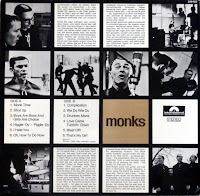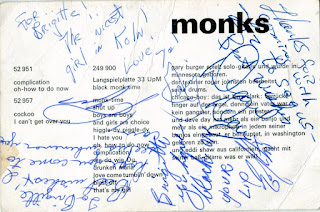About five years ago I traded my perfect copy of Mellow Candle's magical Swaddling Songs for what seemed an embarrassment of other rare records (to be precise: Skip Bifferty, Fresh Maggots and Amaryllis by Bread Love & Dreams). I was confident I'd got the better of the deal, and that I would find another copy of Swaddling Songs soon enough. How wrong I was - I haven't encountered another since, and the few that have popped up on eBay have sold for as much as $2650. But enough of my self-pity.
Mellow Candle came from Dublin, and centred on the talents of teenage friends Clodagh Simonds and Alison Williams (now O'Donnell). They actually made a 45 as a duo in 1968, issued on Simon Napier-Bell's short-lived SNB label, before returning to Ireland and regrouping as a band. Their album was taped in London in the winter of 1971, and appeared on Deram the following April (trailed by a 45 pairing 'Dan The Wing' and 'Silversong', issued on March 31st). Both sank like stones (to borrow an idiom from the album), and the band didn't last much longer. Part of the reason such records sell for so much today is that the mayfly-like acts that made them left behind so little (both in the way of music and press coverage), inadvertently creating considerable mystique in the process. Perhaps surprisingly, two different ads for Swaddling Songs appeared in the British music press at the time (both designed by David Anstey, also responsible for their memorable LP cover):
While putting Galactic Ramble together, I encountered only one review of the album, which appeared in Disc on June 3rd. ‘The kind of group that suffers from being pigeon-holed into a loosely-based folk category, merely because there doesn’t seem to be anything more appropriate to class them in', it begins. 'Mellow Candle are not a folk band as such, although they have a similar enthusiasm and tone to Steeleye Span, and no traditional material, on this album at any rate. The band shares the writing, with pianist Clodagh Simonds carrying a lot of it. With the other lady vocalist, Alison Williams, the songs are sung mainly by the girls in harmony. Too stately in places to be rock, and too fast-moving in others to be folk, they rely a lot on the piano, to good effect.’ It's considerably more sympathetic and accurate than most such pieces of the time, but did nothing to help sales.
The album and the 45 have been established as serious collectibles for decades, in which time the cult reputation of the band has grown and grown, to the extent that the members have been interviewed repeatedly. Seemingly little remained to be discovered about them, so it was pretty astonishing when a hitherto unknown picture sleeve popped up on eBay shortly before Christmas. Here it is (the full version of the image on the back can be seen at the top of this post):
It sold to a serious collector for nearly £400. The seller was clearly in good faith, but questions were soon being asked. Was it genuine? If so, why were no other copies known to have surfaced? And how had it eluded the attentions of vinyl bloodhounds for so long? Was it a mock-up, created by Decca's art department but never issued? That might explain its rather crude feel and anomalous typography compared to other Decca releases of the time - but why would they have bothered in the first place? Simonds and O'Donnell had no recollection of the sleeve, and nor had their manager or David Hitchcock (who produced the 45). All possible explanations for its provenance being genuine seemed unlikely, and the seller decently agreed to reverse the transaction. Has anyone reading this seen another copy?
As a somewhat ironic postscript, Alison O'Donnell does in fact possess a genuine picture sleeve for the single (with the same design on both sides). She recalls little about its manufacture, but thinks it must have been made in tiny quantities by the band's management to house promo 45s in March 1972. Here it is:
UPDATE: in May 2011 a copy of this sold on eBay for £620. Here it is:
Finally, here's a brief interview I conducted with Clodagh a few years back:
What do you remember about the album sessions?
Very, very little! But I think David Hitchcock deserves a medal for getting such a cohesive album out of a bunch of spaced-out teenage hippies. The first sessions were pretty rough, but rather than just dump the project he suggested changes in the line-up and lots more rehearsals, staying patient, tactful, encouraging and calm until we finally got it finished. Buy that man a drink!
Why do you think Swaddling Songs failed to sell?
At the time it sounded rough compared to Fairport and Steeleye Span, though I guess our passion and conviction make it engaging. Deram may well have been waiting for us to start gigging properly before promoting it, but we just couldn’t get live work. Agents felt we weren’t engaging to watch – a bit wooden and self-absorbed. Probably fair criticism! Also, Thin Lizzy were suddenly taking off, and our shared manager wasn't able to give us as much time and energy as before.
How do you account for its ongoing popularity?
I think it sounds good now because there’s been a return to lo-fi, slightly-rough-around-the-edges recordings. At the time our lack of polish went against us, so it’s wonderfully ironic that nowadays it works in our favour. I also feel there’s been a return to fundamental songwriting skills, maybe as a backlash against years of linear, sampled, techno-type music. I’m surprised and very flattered by the attention, especially Stephen Malkmus’s cover of ‘Poet & The Witch’. I was very chuffed about that! Mellow Candle was all about songs, really, and we had three good writers all in one band, which I suppose is fairly unusual, and meant there was real variety in the music.












































